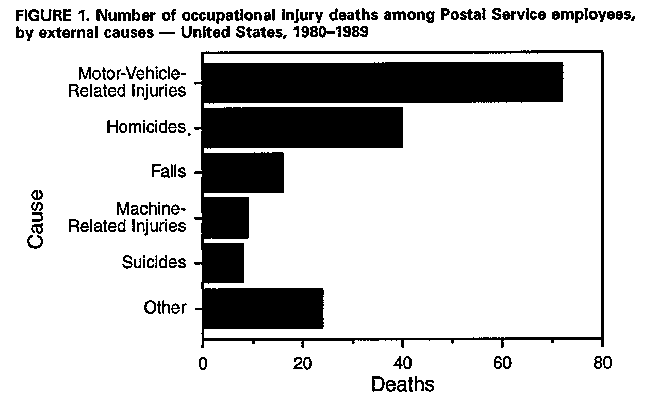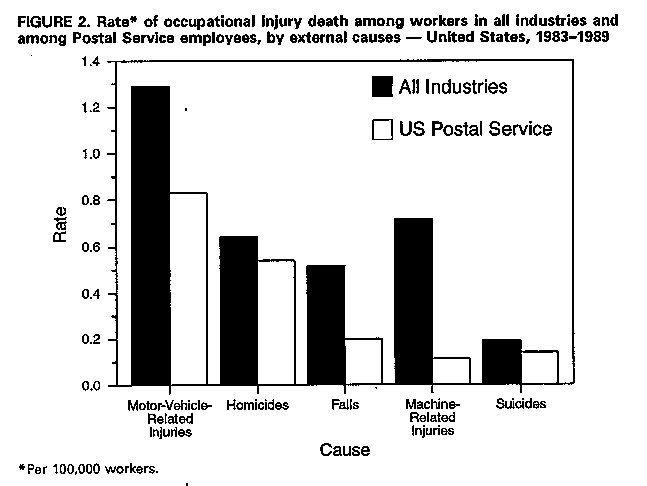 |
|
|
|
|
|
|
| ||||||||||
|
|
|
|
|
|
|
||||
| ||||||||||
|
|
|
|
|
Persons using assistive technology might not be able to fully access information in this file. For assistance, please send e-mail to: mmwrq@cdc.gov. Type 508 Accommodation and the title of the report in the subject line of e-mail. Occupational Injury Deaths of Postal Workers -- United States, 1980-1989Extensive media coverage of work-related homicides at U.S. Postal Service facilities raised the concern about whether postal workers are at increased risk for work-related homicide, particularly from those committed by disgruntled coworkers. Based on national surveillance data, neither the Postal Service industry nor postal occupations are among the groups at increased risk for work-related homicide (1,2). To further assess this concern and to determine the relative magnitude of occupational injury deaths in the Postal Service, CDC's National Institute for Occupational Safety and Health (NIOSH) used data from its National Traumatic Occupational Fatalities (NTOF) surveillance system * to examine occupational injury deaths in the Postal Service and compare Postal Service fatality rates with overall rates for all U.S. industries. This report summarizes the results of that analysis. NTOF data for 1980 through 1989 (the most recent year for which complete data are available) were analyzed. Employment data for the calculation of rates were derived from the Current Population Survey (4). Rates were calculated only for 1983-1989 because reporting of Postal Service employment data changed in 1983. NTOF recorded 169 occupational injury deaths among U.S. Postal Service workers during 1980-1989. During 1983-1989, the average annual rate of occupational injury death in the Postal Service was 2.1 per 100,000 workers, less than half the rate of 5.4 per 100,000 workers for all industries combined. Men accounted for 130 (77%) of the occupational injury deaths in the Postal Service and had a higher rate of fatal injury than did women (2.3 per 100,000 workers, compared with 1.8). A total of 98 (58%) of the decedents were aged greater than 45 years. Motor-vehicle-related events (n=72) were the leading cause of fatal occupational injury, followed by homicide (n=40) (Figure_1), (page 593). Cause-specific rates for Postal Service employees were consistently lower than rates for all industries, with the largest differential in the category of machine-related deaths (Figure_2), (page 593). Collisions between motor vehicles caused 43 (60%) of the motor-vehicle-related deaths among Postal Service workers. Three (4%) deaths occurred to pedestrians on the job who were struck by motor vehicles. Fifty-one (71%) deaths occurred among mail carriers and eight (11%) among drivers. Among homicide victims, 26 (65%) were men. The homicide rate for men was 0.5 per 100,000, compared to 0.6 for women. Firearms were used in 34 (85%) of the homicides. Seventeen (43%) of the victims were mail carriers; nine (23%), postal clerks; five (13%), postmasters and mail superintendents; and three (8%), other specified occupations. Occupation was unknown or not specified for six (15%) of the victims. Reported by: Div of Safety Research, National Institute for Occupational Safety and Health, CDC. Editorial NoteEditorial Note: The findings in this report indicate that the occupational fatality rate for U.S. Postal Service workers is approximately 2.5 times lower than that for all workers combined. Motor-vehicle-related events and homicides combined accounted for 66% of occupational injury deaths in the Postal Service. This analysis indicated an occupational homicide rate among Postal Service workers that did not exceed the rate for all U.S. workers. Media attention to violence in Postal Service facilities resulted in press reports that enumerated violent incidents over a defined period (1983 through 1993). By comparing a newspaper review of occupational violence in the Postal Service (5) with cases reported in NTOF, NIOSH identified five work-related homicides not included in the NTOF database. Incorporating these five cases into the calculation of a work-related homicide rate for the Postal Service increased the rate to 0.63 per 100,000 workers, nearly equal to the average overall national rate (0.64) for the same period. However, it was not practical to similarly identify work-related homicides that were not included in NTOF for other industries; such an enumeration of missed cases would probably increase the average annual all-industries rate. Although the occupational homicide rate for the Postal Service industry is similar to the national rate for all industries, coworkers appear to be disproportionately responsible for homicides that occur in the Postal Service. During 1992, 82% of work-related homicides were associated with robberies or miscellaneous crimes; only 4% were committed by coworkers or former coworkers (6). By comparison, the NTOF data in this report, supplemented with information from the newspaper review (5), indicated that 57% (20/35) of work-related homicides of postal workers from 1983 through 1989 were committed by coworkers or former coworkers. However, 14 of the 20 coworker homicides occurred in a single incident. The remaining 15 postal worker homicides were presumed to have been committed by persons who were not Postal Service employees. The findings in this report are subject to at least three limitations (3). First, because the NTOF surveillance system is based only on data from death certificates, occupational injury deaths are undercounted; on average, death certificate-based surveillance systems capture approximately 81% of occupational injury deaths (7). Second, previous studies have demonstrated 60%- 76% agreement between industry and occupation information listed on death certificates and actual employment status at the time of death (3), which could be a source of misclassification. Third, death certificates provide only limited data about the circumstances of traumatic fatalities. Although postal workers do not appear to be at increased risk for occupational homicide, homicide was the third leading cause of occupational injury death in the United States from 1980 through 1989 (1,3). Developing strategies for the prevention of work-related homicide will require examination of the circumstances (e.g., location and working conditions) in which violence has previously occurred. Factors that may increase the risk for homicide among mail carriers are working alone in a community setting, carrying currency and other valuables, and working in high-crime areas (1,2). Enhanced security measures and devices may be appropriate to reduce assaults occurring within Postal Service facilities. Determining the risk factors for coworker violence will require assessing individual incidents to determine whether there were preceding indications of impending violence (e.g., threats) and evaluating work conditions and management practices that could reduce the risk for violence. As part of such an effort, additional study is needed of behavioral factors that can lead to violence between coworkers and improved surveillance of nonfatal occupational injuries incurred through violence. In addition to addressing occupational injury deaths resulting from violence, the NTOF data reported here highlight a need to continue to address the risk for motor-vehicle-related injuries. Postal Service employees drive approximately 1.5 billion miles on the job each year (J. Jones, Office of Safety and Health, U.S. Postal Service, personal communication, 1994). Use of safety belts, maintaining mechanical integrity of the fleet (both Postal Service and personal vehicles used in the performance of duties), and training should be evaluated to identify means by which the Postal Service can reduce the risk for motor-vehicle-related fatalities. References
* NTOF is based on death certificates compiled from all 52 vital statistics reporting units in the United States that meet three criteria: the decedent was greater than or equal to 16 years of age, the cause of death was an injury or poisoning according to the International Classification of Diseases, Ninth Revision, and the certifier responded positively to the "Injury at Work?" question (3). Figure_1  Return to top. Figure_2  Return to top. Disclaimer All MMWR HTML versions of articles are electronic conversions from ASCII text into HTML. This conversion may have resulted in character translation or format errors in the HTML version. Users should not rely on this HTML document, but are referred to the electronic PDF version and/or the original MMWR paper copy for the official text, figures, and tables. An original paper copy of this issue can be obtained from the Superintendent of Documents, U.S. Government Printing Office (GPO), Washington, DC 20402-9371; telephone: (202) 512-1800. Contact GPO for current prices. **Questions or messages regarding errors in formatting should be addressed to mmwrq@cdc.gov.Page converted: 09/19/98 |
|||||||||
This page last reviewed 5/2/01
|